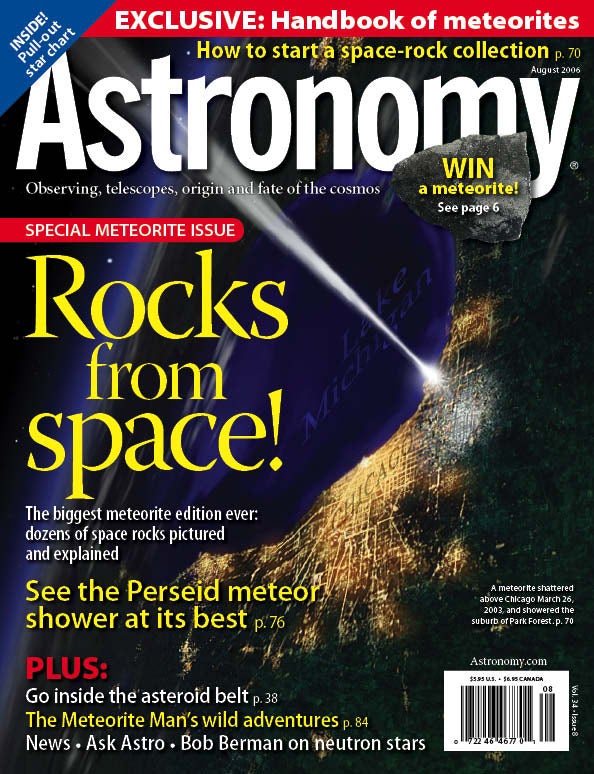
More Astronomy resources:
Astronomy news
This week’s sky events
Astronomy basics
Glossary of astronomical terms
Return to Astronomy “For the media” page
Matt Quandt
Assistant editor
[t] 262.796.8776 x419
[e] mquandt@astronomy.com
June 30, 2006
Space rocks
Astronomy magazine – the world’s best-selling magazine dedicated to the hobby and science of astronomy – devotes its August 2006 issue to space rocks. This special edition brings together the world’s foremost authorities on meteorites to examine where these well-traveled rocks come from, what they’re made of, and how they affect our planet.
Astronomy editors – meteorite aficionados in their own right – are happy to discuss how to find space rocks; what these rocks tell us about our solar system; and how frequently meteorites strike Earth, the Moon, Mars, and other planets.
To set up an interview, please contact Matt Quandt at 262.796.8776 x419.
“Unlocking the solar system’s past”
University of Arizona’s David Kring, a meteorite expert, describes the latest science of meteorites. There’s a treasure trove locked inside meteorites, rare particles older than Earth. Kring, the founding director of the University of Arizona Meteorite Recovery Program, describes how “Scientists tease our origins from primitive stone meteorites, 4.56 billion-year-old relics of the solar system that predate Earth’s formation.” A colorful, easy-to-understand diagram, “Meteorite origins,” illustrates how different meteorite classes reveal different parts of the solar system’s history.
“Between a rock and a gas giant”
This super illustration gives readers a tour of the belt of mini-planets between Mars and Jupiter. More than 600,000 asteroids are known, and most of them lie between the two planets. But some cross Earth’s orbit, and others inhabit the frigid outer solar system. Get up close and personal with some of the solar system’s best-known asteroids.
“Earth under fire”
Our planet’s surface is riddled with craters formed by high-speed cosmic impacts. Astronomy Contributing Editor Mike D. Reynolds explains how meteorite impacts range from quite small to extremely large. “Our Moon owes its very existence to a colossal impact,” Reynolds says, “It formed from debris created when a Mars-size object struck the early Earth.”
“Blast from the past”
Fifty thousand years ago, a multimegaton impact gouged out Arizona’s Meteor Crater. David Kring’s second contribution to this special edition takes readers inside this giant crater as well as the impact that created it. “This asteroid impact site,” Kring writes, “is one of the best-preserved impact sites on Earth, offering an incredible view of nature’s destructive power.”
The blast that formed the crater excavated 175 million metric tons of rock. According to Kring, “If the same impact were to occur in a major city today, it would destroy the city.”
“Classic rock” – “Heavy metal” – “Rock-metal fusion” – “Name that rock”
Four posters in this issue present meteorite classifications. In the first three, Astronomy Senior Editor Michael E. Bakich provides images, weights, and locations of the three kinds of meteorites: stone, iron, and stony-iron. For the fourth, Bakich explains how scientists classify meteorites by what they’re made of and where they come from. Three charts outline the telltale characteristics of stone meteorites, iron meteorites, and stony-iron meteorites.
“The great interplanetary rock swap”
Some meteorites come from the Moon, others from Mars. Bill Cooke, an astronomer at NASA’s Marshall Space Flight Center, explains how space rocks arrive. About 7 percent of rocks blasted off of Mars make their way to Earth. Because space objects trade debris, Cooke wonders, “If we find evidence life once existed on Mars, can we be certain it arose there?”
“How to start your meteorite collection”
The author of The Cambridge Encyclopedia of Meteorites, O. Richard Norton explains everything readers need to start acquiring space rocks. As with any collector’s item, meteorites range from a few dollars to thousands a gram. “As with the Mars rocks,” Norton explains, “lunar meteorites have prices that are truly astronomical – $2,500 to $3,000 per gram.”
“Rock star”
Meteorite dealer Robert Haag – a.k.a. “The Meteorite Man” – travels the world in search of space rocks. Astronomy Contributing Editor Raymond Shubinski’s profile of Haag recounts the meteorite collector’s adventures to remote places in the world and takes readers inside Haag’s home vault in Tucson, Arizona – with contents worth millions. “What do you get if you cross Indiana Jones with a rock star?” Shubinski asks. “My answer is Robert Haag.”
Also in the issue
The August 2006 Astronomy also includes Ask Astro, Astro news, Bob Berman’s strange universe, Glenn Chaple’s observing basics, Phil Harrington’s binocular universe, The sky this month, New products, and Reader gallery.
Astronomy‘s mission
Astronomy promotes the science and hobby of astronomy through high-quality publications that engage, inform, entertain, and inspire.









